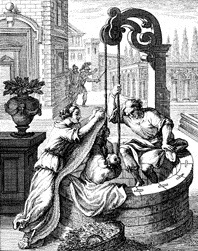1. Overview
Ahimaaz (אֲחִימַעַץʾĂḥīmaʿaṣHebrew, "My Brother Is Counselor") was a significant figure in the Hebrew Bible, primarily known for his unwavering loyalty to King David and his eventual succession as High Priest of Israel under King Solomon. As the son of Zadok, the High Priest, Ahimaaz played a crucial role as a swift and reliable messenger during the tumultuous period of Absalom's revolt against King David. His actions demonstrated his dedication to the monarchy and his family's priestly duties, solidifying his place in the history of ancient Israel.
2. Background
Ahimaaz's life and roles were deeply intertwined with his family's prominent position within the Israelite priesthood, establishing his lineage and context within the religious and political structure of ancient Israel.
2.1. Patrilineal Ancestry
Ahimaaz was the son of Zadok, who served as the High Priest during the reigns of King David and King Solomon. This lineage placed Ahimaaz within the esteemed priestly family descended from Aaron, ensuring his inherited right to priestly duties. Following the death of his father, Zadok, Ahimaaz was destined to assume the mantle of High Priest, continuing a significant line of religious leadership within Israel.
3. Key Activities and Roles
Ahimaaz performed several vital actions and duties throughout his life, particularly in his service to the monarchy and his responsibilities within the priesthood.
3.1. Loyalty to King David
Ahimaaz first appears in the biblical narrative during the reign of King David (c. 1000-962 BCE). During Absalom's rebellion, Ahimaaz remained steadfastly loyal to King David. He, along with Jonathan, son of Abiathar, played a critical role in assisting David by relaying vital information about Absalom's proceedings in Jerusalem. They served as secret messengers, hiding near En Rogel to receive intelligence from David's loyalists within the city, such as Hushai and Ahithophel (2 Samuel 15:24-37; 17:15-21).
Ahimaaz was renowned for his exceptional speed as a runner. Following the defeat of Absalom's forces, Ahimaaz was the first to bring news of the victory to King David. Despite his swiftness, he deliberately refrained from mentioning Absalom's death, perhaps out of sensitivity to David's deep affection for his rebellious son (2 Samuel 18:19-33). His actions during this period underscore his reliability, discretion, and unwavering commitment to King David.
3.2. Service as High Priest
Under the reign of King Solomon (c. 970-930 BCE), Ahimaaz's father, Zadok, continued to serve as High Priest. Upon Zadok's death, Ahimaaz succeeded him in this esteemed position. As High Priest, Ahimaaz would have been responsible for overseeing the religious rituals, sacrifices, and general administration of the Tabernacle or the nascent Temple services, playing a central role in the spiritual life of Israel (1 Chronicles 6:8, 53).
4. Personal Life
Beyond his public roles, the biblical accounts offer a glimpse into Ahimaaz's personal life, including a notable familial connection through marriage.
4.1. Possible Marriage to Basemath
The Bible suggests that Ahimaaz may have married Basemath, one of King Solomon's daughters (1 Kings 4:15). If this identification is correct, it would signify a significant union between the royal house of David and the prominent priestly lineage of Zadok. Such marriages were not uncommon in ancient Israel, as evidenced by later kings, such as Ahaz, who also married daughters of the high priest, further cementing the close ties between the monarchy and the priesthood.
5. Significance and Legacy
Ahimaaz holds a notable place in biblical history due to his unwavering loyalty, his pivotal role as a messenger during a critical period, and his succession to the highest priestly office. His actions during Absalom's revolt highlight his personal qualities of swiftness, discretion, and faithfulness, which were invaluable to King David. As a High Priest, he continued the distinguished lineage of Zadok, ensuring the continuity of the priesthood during the early monarchical period. His potential marriage to a daughter of Solomon further underscores his integration into the highest echelons of Israelite society, symbolizing the intertwined nature of religious and political authority in the kingdom.
